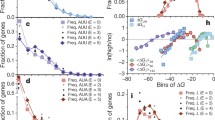Abstract
Many modern investigations study important gene characteristic such as the efficiency of its expression. As is known, it is determined at the levels of transcription, translation, posttranslational modification, etc. The EloE (Elongation Efficiency) program, which sorts the organism genes in order of decreasing their supposed translation elongation rate based on the analysis of their nucleotide sequences, is presented in the work. The obtained theoretical data are significantly correlated to the available experimental data on gene expression in different organisms (for example, S. cerevisiae and H. pylori). The program also detects preferential codons in the organism genome and constructs the distribution of the stability of potential secondary structures near the mRNA 5′- and 3′-ends. The program can be used for preliminarily estimating the level of gene expression in the studied organism (for which the experimental data are not available yet). The results of EloE can be transferred in third-party program instruments that model artificial genetic constructions for genetically engineered experiments.
Similar content being viewed by others
References
Bennetzen, J.L. and Hall, B.D., Codon selection in yeast, J. Biol. Chem., 1982, vol. 257, no. 6, pp. 3026–3031.
Eck, S. and Stephan, W., Determining the relationship of gene expression and global mRNA stability in Drosophila melanogaster and Escherichia coli using linear models, Gene, 2008, vol. 1, no. 1, pp. 102–107.
Hofacker, I.L., Vienna RNA secondary structure server, Nucleic Acids Res., 2003, vol. 31, no. 13, pp. 3429–3431.
Ikemura, T., Correlation between the abundance of Escherichia coli transfer RNAs and the occurrence of the respective codons in its protein genes: a proposal for a synonymous codon choice that is optimal for the E. coli system, J. Mol. Biol., 1981, vol. 151, no. 3, pp. 389–409.
Likhoshvai, V.A. and Matushkin, Yu.G., Nucleotide composition-based prediction of gene expression efficacy, Mol. Biol. (Moscow), 2000, vol. 34, no. 3, pp. 345–350.
Likhoshvai, V.A. and Matushkin, Y.G., Differentiation of single cell organisms according to elongation stages crucial for gene expression efficacy, FEBS Lett., 2002, vol. 1, no. 1, pp. 87–92.
Lopinski, J.D., Dinman, J.D., and Bruenn, J.A., Kinetics of ribosomal pausing during programmed-1 translational frame shifting, Mol. Cell. Biol., 2000, vol. 20, no. 4, pp. 1095–1103.
Matushkin, Yu.G., et al., Efficacy of elongation yeast genes is correlated with the nucleosome packing density in the 5′-untranslated region, Matem. Biol. Bioinform., 2013, vol. 8, no. 1, pp. 248–257.
McLachlan, A.D., Staden, R., and Boswell, D.R., A method for measuring the non-random bias of a codon usage table, Nucleic Acids Res., 1984, vol. 12, no. 24, pp. 9567–9575.
Sharp, P.M. and Li, W.H., An evolutionary perspective on synonymous codon usage in unicellular organisms, J. Mol. Evol., 1986, vol. 24, nos. 1–2, pp. 28–38.
Sokolov, V.S., Likhoshvai, V.A., and Matushkin, Y.G., Gene expression and secondary mRNA structures in different mycoplasma species, Russ. J. Genet. Appl. Res., 2014, vol. 4, no. 3, pp. 208–217.
Takyar, S., Hickerson, R.P., and Noller, H.F., mRNA helicase activity of the ribosome, Cell, 2005, vol. 120, no. 1, pp. 49–58.
Thanaraj, T.A. and Argos, P., Ribosome-mediated translational pause and protein domain organization, Protein Sci., 1996, vol. 5, no. 8, pp. 1594–1612.
Vladimirov, N.V., Likhoshvai, V.A., and Matushkin, Y.G., Correlation of codon biases and potential secondary structures with mRNA translation efficiency in unicellular organisms, Mol. Biol., 2007, vol. 41, no. 5, pp. 843–850.
Zuker, M., Mfold web server for nucleic acid folding and hybridization prediction, Nucleic Acids Res., 2003, vol. 31, no. 13, pp. 3406–3415.
Zuker, M., Mathews, D.H., and Turner, D.H., Algorithms and thermodynamics for rna secondary structure prediction: a practical guide, in RNA Biochemistry and Biotechnology, Netherlands: Springer, 1999, pp. 11–43.
Author information
Authors and Affiliations
Corresponding author
Additional information
Original Russian Text © V.S. Sokolov, B.S. Zuraev, S.A. Lashin, Yu.G. Matushkin, 2014, published in Vavilovskii Zhurnal Genetiki i Selektsii, 2014, Vol. 18, No. 4/2, pp. 904–909.
Rights and permissions
About this article
Cite this article
Sokolov, V.S., Zuraev, B.S., Lashin, S.A. et al. EloE: Web application for estimation of gene translation elongation efficiency. Russ J Genet Appl Res 5, 335–339 (2015). https://doi.org/10.1134/S2079059715040140
Received:
Accepted:
Published:
Issue Date:
DOI: https://doi.org/10.1134/S2079059715040140




